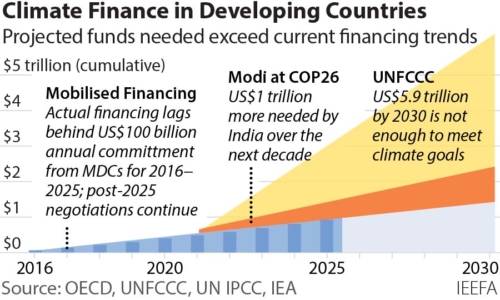IEEFA India: Developed countries will have to massively scale up climate finance

The COP26 summit in Glasgow saw big carbon-emitting countries including India commit to net zero emissions (NZE) and a deal between the U.S and China, the two biggest emitters, to ramp up climate cooperation, including reducing methane emissions as an urgent priority, protecting forests and phasing down coal. However, despite major breakthroughs, the conference has failed to deliver on climate finance, which is going to be critical to meeting the Paris targets.
In response, developing countries are protesting against ‘carbon colonisation’ and seeking ‘climate justice’. A group called the Like-Minded Developing Countries (LMDC), comprising 22 countries including India and China, has formed to call out developed countries for attempting to transfer the burden of their historical responsibility for climate change to the rest of the world. It argues that expecting developing countries to achieve NZE by 2050 – the same date as developed countries – is against climate justice, the principles of equity and common but differentiated responsibilities.

Enhancing climate finance globally
Donor countries have fallen well short of the US$100 billion commitment per year by 2020 agreed at COP16 in 2010 and reiterated and extended to 2025 at COP21. It was a central element of the Paris Agreement. Yet, the target is set to be achieved three years late, by 2023. It is also not enough to meet climate goals – developing countries will need US$5.9 trillion up to 2030. And, with the raising of ambition, demands for finance have increased further.
Developing countries will need US$5.9 trillion up to 2030 to meet climate goals
Developing countries’ demands to access finance through favourable channels, such as grants and concessional debt have not been adequately met. In 2019, the total climate finance provided by developed countries for developing countries was US$79.6 billion in 2019. Much of this finance is mobilised through bilateral and multilateral public financing. The share of private financing is marginal.
Bilateral and multilateral public climate finance from developed to developing countries has increased at a modest pace, rising from US$38 billion in 2013 to US$63 billion in 2019. Most of the increase has been in the form of concessional and semi-concessional loans. Climate-related export credits remained small at US$2.6 billion, accounting for just 3% of the total climate finance.
Asia was the main beneficiary of climate finance during 2016-19, with an average share of 43%. Africa’s share of the total finance was 26%, while Latin America’s share was 17%.
US$1 trillion shouldn’t be the ceiling
According to the International Energy Agency’s (IEA) India Energy Outlook 2021, India would need US$110 billion annually for the deployment of renewable energy, battery storage, electric vehicles, network expansion and modernisation of the grid under the Sustainable Development Scenario (SDS). This is about three times the current annual investment (US$40 billion) in these sectors. However, the corresponding investment requirement to achieve the NZE roadmap would be much higher than for the SDS.
Capital subsidies for fossil fuel projects must end
At COP26, Prime Minister Narendra Modi demanded that rich countries provide as much as US$1 trillion in climate finance just for India over the next decade – far more than the US$100 billion a year for all developing countries sought under previous deals.
IEEFA notes that India has been successful in raising private global capital. But it is key that concessional public capital pivots from ongoing capital subsidies for yet more fossil fuel import projects to catalysing deployment of proven new zero-emissions technologies at scale in the domestic context.
The unfulfilled finance promises are a breach of trust and so developing countries have made achieving climate goals conditional on clarity on climate finance. Now, developed countries will have to meet their own NZE targets as well as provide more finance to developing countries than the initial US$100 billion planned. Although US$1 trillion is the new ask, it should not be the ceiling. Developed countries should be prepared to enhance climate finance even further.
Raising climate ambition in line with Paris
The Emissions Gap Report 2021 reveals that if emissions goals are implemented effectively, NZE pledges could limit warming to 2.2°C. This implies the need for a global ratcheting up of climate goals, collectively, which, in turn, would require a scaling up of climate finance.
Canada, Japan and Germany reaffirmed their commitment to contribute US$100 billion annually through to 2025. In September, the EU pledged an extra US$5 billion by 2027, the UK increased its commitment to £11.6 billion (US$15.6 billion) in the next four years and President Joe Biden promised that the U.S. would provide US$11.4 billion in annual financing by 2024. However, these pledges are still inadequate, and also lack immediacy.
The US$100-billion pledge is minuscule in comparison with the investment required to meet the Paris goals. Developed countries will have to massively scale up climate finance, cease providing fossil fuel capital subsidies and prioritise grant-based financing in addition to debt and equity infusion which will help attract private investment into areas where that financing would not otherwise be available. Furthermore, private capital is not yet flowing in the volumes necessary to make the transition to net-zero emissions at the required speed.
By Vibhuti Garg, IEEFA Energy Economist, Lead India and Shantanu Srivastava, IEEFA Energy Finance Analyst
This article first appeared in the Economic Times
Related articles
IEEFA: For India’s ‘RE+’ goals, capital is key
IEEFA: Innovative financing can help India achieve its renewable energy goals
















